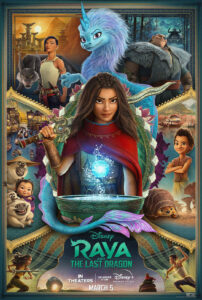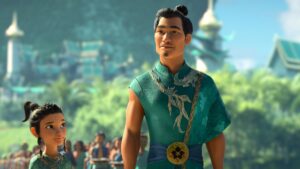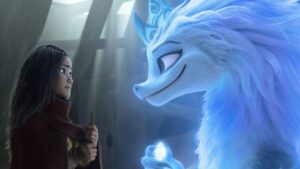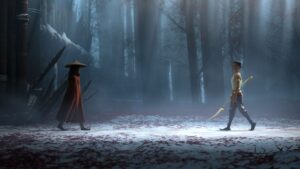 From Walt Disney Animation Studios, the studio behind Moana and Frozen, comes the release of their latest animated feature film, Raya and the Last Dragon. While all three animated films feature strong female leads, Raya and the Last Dragon presents Disney’s first Southeast Asian princess, with authentic Asian representation embedded in all aspects of the film.
From Walt Disney Animation Studios, the studio behind Moana and Frozen, comes the release of their latest animated feature film, Raya and the Last Dragon. While all three animated films feature strong female leads, Raya and the Last Dragon presents Disney’s first Southeast Asian princess, with authentic Asian representation embedded in all aspects of the film.
Directors Don Hall (Moana) and Carlos López Estrada (Blindspotting) lead the team of Raya and the Last Dragon with Paul Briggs (Big Hero 6) and John Ripa (Zootopia) serving as Co-Directors. The screenplay is penned by Vietnamese-American screenwriter Qui Nguyen (Dispatches from Elsewhere) and Malaysian screenwriter Adele Lim (Crazy Rich Asians) in collaboration with the story team.
In a fantasy realm known as Kumandra, dragons and humans lived peacefully with one another connected through one land, until a mindless plague known as the Druun appeared and began turning them into stone. To save the land, the dragons sacrificed themselves by fusing their magic together to create an energy orb known as the Dragon Gem, which put a stop to the pestilent Druun. Without the dragons to keep harmony in the land, the greed of the people caused Kumandra to split into the five separate regions of Fang, Talon, Heart, Spine and Tail, which form the shape of a dragon. The five regions are inspired by the Southeast Asian countries of Cambodia, Indonesia, Laos, Malaysia, Myanmar, Singapore, Thailand, Vietnam, and the Philippines. After 500 years, the energy orb is under the protection of the Heart Tribe Chief Benja, voiced by Daniel Dae Kim (Lost). Chief Benja attempts to reunite Kumandra by inviting the people of the other lands to gather and make peace. However, the other lands have their own hidden agendas and the event ends catastrophically as they fight over the energy orb, believing it may bring them prosperity. Soon after, the vile Druun reappear causing major uproar and desolating the population. It is up to Benja’s daughter Raya, voiced by Kelly Marie Tran (Star Wars: Episode IX – The Rise of Skywalker) to awaken the last dragon Sisu, voiced by Awkwafina (The Farewell) in the hopes of eliminating the wretched Druun and restoring humanity.

On Raya’s journey to awaken the legendary Sisu and obtain the pieces of the shattered Dragon Gem, she runs into a few unique supporting characters voiced by a stellar Asian cast in Izaac Wang (Good Boys) as Boun from the Tail Land, Benedict Wong (Doctor Strange) as Tong from the Spine Land, and Thalia Tran (Little) as Baby Noi from the Talon Land. The ones that stand in Raya’s path are her nemesis princess Namaari, voiced by Gemma Chan (Crazy Rich Asians) and Namaari’s mother Virana (Sandra Oh) of the Fang Land.
The animation for Sisu visually mesmerizes as a blue flowing dragon, inspired by the shape of water with four legs. The dragon’s cartoony appearance and silly personality provide humor and entertainment, which balance the intensity and seriousness of Raya. The water represents the connection between the five lands and the design for Sisu portrays Raya’s emotional growth. The animation of each of the five lands takes a unique shape with characteristic styles. The Heart Land emerges very blue with the water surrounding the land. Fang’s landscapes appear to be design oriented with geometric shapes and a military vibe, much like a design aspect in Cambodia’s Angkor Wat. The Talon Land looks to be inspired by the night markets in Laos, Indonesia, or Thailand. The Spine Land depicts giant black bamboo trees in reference to Vietnam. The Tail Land is an empty desert near the end of Kumandra’s Dragon River, which most likely signifies the Mekong River that runs through Southeast Asia.

The fight scenes in the animated movie resemble that of a live action martial arts film. They are inspired by the real life martial arts of Arnis (known as Kali or Eskrima/Escrima, the national martial art of the Philippines), Muay Thai kickboxing (Thailand), Pencak Silat (Malaysia, Indonesia), and traditional Vietnamese wrestling (Vietnam). Raya’s fighting style ranges from Arnis/Eskrima/Kali and sticks to Pencak Silat with her weapon of choice being a Keris (Kris), an asymmetrical dagger from the island of Java in Indonesia. Namaari’s style is based on Muay Thai kickboxing with weapons including the Krabi-Krabong, also from Thailand. The fight scenes between Raya and Namaari demonstrate a Pencak Silat fighter and a Muay Thai fighter throwing knees and elbows at each other.
Unlike many other Disney animated films, Raya and the Last Dragon is not a musical. The film features an original score from Composer James Newton Howard (Fantastic Beasts and Where to Find Them), which consists of 23 individual tracks which utilize instruments frequently heard within the traditional Southeast Asian culture of hand drums, lutes, and chimes. A blend of computer synthesized musical pulses are embedded into certain tracks to heighten the fast-paced and high intensity action sequences. The movie’s theme song comes from Jhené Aiko entitled “Lead the Way” which is also played over the trailer. The soundtrack also features the first-ever Filipino-language song in a Disney animation feature by KZ Tandingan titled “Gabay.”

Raya and the Last Dragon is one of the few Disney movies that truly showcases Asian abilities and talents from the writing, voice acting, and animation. The Southeast Asian countries of Cambodia, Indonesia, Laos, Malaysia, Myanmar, Singapore, Thailand, Vietnam, and the Philippines are authentically embodied from the story, food, landscapes, costumes, martial arts, and the culture. The timing couldn’t be more perfect for an Asian-centric Disney release, given the climate of the country and the demand for more diversity and equal opportunity within Hollywood. The film will open doors for future Asians in all aspects of film and animation production within the cast and crew, and also provides Asian people the opportunity to see their own images and cultures represented on the screen. The powerful message within Raya and the Last Dragon is something we all need to explore and take to heart.
Raya and the Last Dragon is available in theaters and streaming on Disney+ with Premier Access.
All photos courtesy of Walt Disney Studios.





